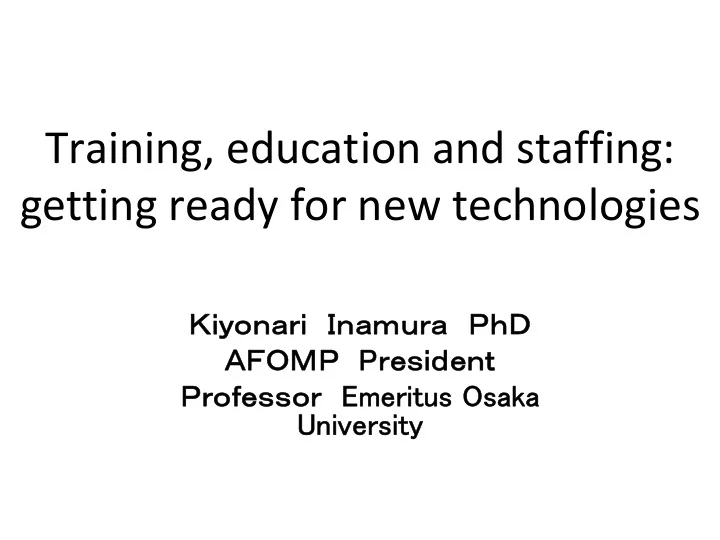

Training, education and staffing: getting ready for new technologies Kiyonari Inamura PhD AFOMP President Professor Emeritus Osaka University
Contents 1. Problems we are now facing 2. Priority of new technologies to be adopted 3. Mission of qualified medical physicists 4. Education and training of MP in AFOMP countries 5. Struggles in AFOMP countries and proposed solution 6. Action plan 7. Cooperation between AFOMP and IAEA 8. Conclusion
Problems we are now facing: 1. How to break down advanced technologies to clinical routine work 2. How to optimize and standardize method of training 3. How to develop structured program 4. How to train trainers
Problems we are now facing 5. How to share instruments/ machines/ systems to be commonly used 6. What is most appropriate staffing 6 ‐ 1: Optimized mix of proper staffs between radiation oncologists, medical physicists and radiological technologists . 6 ‐ 2: Appropriate number of staff per patient?
How to prioritize new technologies to be adopted? Heavy particles, Proton, Neutron, ・・・ ,? 1. IMRT, IGRT, Tomotherapy, ・・・ , ? 2. PET, PET ‐ CT, Multi ‐ slice CT, ・・・ , ? 3.
Vertical climbing up to top ranked technologies, or horizontal spread of base lined ones? Highly advanced technology broken down to comprehensive appropriate technologies
Advanced technologies vs. appropriate technologies 1. How many patients can enjoy the highest technology? 2. By what cost? 3. Medical technology assessment: effectiveness, efficacy, efficiency, economy, cost/performance, validation ・・・ .
Mission of qualified medical physicists Commissioning of highly advanced modalities applicable to clinical routine works Defining problems in clinical routine works Solving the problems by highly advanced technologies Performing QA/QC /Security procedure
Education of medical physicists toward top ranked technologies Education of fundamental physics as basic sciences Education of medical statistics, mathematics and information sciences Research works of figuring out effectiveness to patients
Clinical training of MP to break down advanced modalities to clinical routine works 1. Fixation of translational research 2. Technology transfer from manufacturers 3. QA/QC program and security enhancement 4. Train trainers 5. Train trainees
Optimization & Standardization 1. Flow charts, clinical critical path and layout 2. QA/QC/Security procedure 3. Protocol for data base 4. Application of medical statistics 5. Normalization of quantitative clinical data 6. Documentation and publication
Optimized mix of man ‐ hours between medical staffs: 1. Oncologists, physicists, technologists, nurses and statistician, ・・・ . Selection of patients to be treated: 1. What is priority? 2. First come, first treated or, 3. Ethical selection committee for patients treated?
Struggles in AFOMP countries and proposed solution • Very few medical physicists training system • Contradiction and friction between radiological technologist versus medical physicist. • Proposed action plan: Implementation of structured training program by RAS6038 “Strengthening Medical Physics”
Education and training of medical physicists in AFOMP countries • AFOMP was founded in July 2000 • AFOMP ETC and PDC were founded in 2001. • Difficulties in defining qualified MP • Diversity in level and quality of MP
Action plans • AFOMP activity based on stable finance • Education and clinical training courses/workshops to be held in both big cities and in provincial cities • Appropriate technologies
Cooperation between AFOMP and IAEA • To review, examine and endorse Tec Doc (technical documents) published by IAEA • Targeting top levelled training tools • Train trainers based on structured program. • Develop tools and portfolios for completion of core competencies. • IAEA/RCA RAS6038 “Strengthening Medical Physics”,
Late comers can enjoy advanced scheme rather fast • Earlier adoption of highly advanced modalities • Work value measurement by time study and evaluation • Value added quality of life should be sought.
Conclusion • Role of MP: To break down highly advanced technologies to clinical routine works • Optimization and standardization of flow charts, critical path , and layout • Train trainers first • Steady process of medical technology assessment • Cooperation between AFOMP and IAEA
Recommend
More recommend